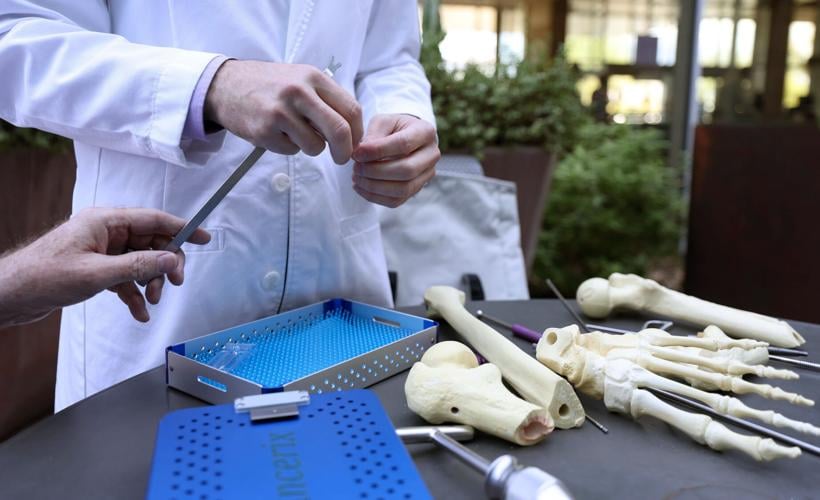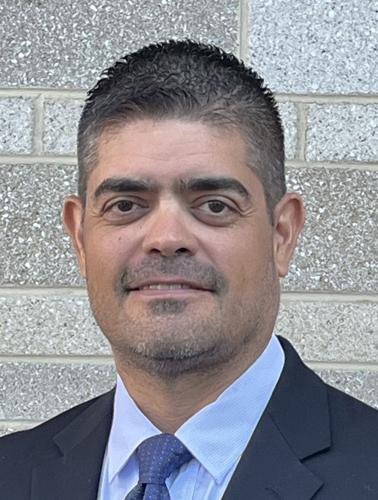Any backyard mechanic knows how difficult and frustrating it can be to remove a screw that is broken or stripped, but with medical hardware like bone screws the matter can be more serious.
Now a Tucson startup, Ancerix, is working to perfect and market new tools to help orthopedic surgeons cleanly remove stuck medical hardware like screws and rods, based on technology invented at the University of Arizona.
And with an experienced Mexican medical-device manufacturing partner aboard and an available fast-track federal process for market clearance, Ancerix is hoping to launch its first toolkit in the fall of 2024.
Ancerix, was co-founded earlier this year by co-inventor Dr. Daniel Latt, an orthopedic surgeon and UA associate professor in the UA College of Medicine-Tucson as well as the College of Engineering, along with veteran medical-device designer Dr. Ramses Galáz and business development expert John Buttery.

Galáz
Latt led the effort to develop the new surgical tools as a “capstone project” by five students in the UA’s Craig M. Berge Engineering Design Program.
Tech Launch Arizona, the UA’s technology commercialization arm, worked with the team to file patents for the two inventions and licensed the intellectual property to Ancerix to bring the inventions to the marketplace.
Problem hardware
Latt says the company’s initial toolkit addresses three main problems with medical hardware: removal of bone screws that become so loose that they can’t be unscrewed; screws overgrown by bone; and broken or damaged “intramedullary nails” — hollow rods placed in the center of long bones like femurs to stabilize the bone.
Screws that have become loose over time because of infection or bone loss can be a real challenge, said Latt, who joined the UA faculty in 2009 and specializes in sports medicine focusing on feet and ankles.
“What happens is you no longer have bone around the threads of the screw, so that when you turn the screw, there’s no force, turning the screw doesn’t create an axial force to drive the screw out anymore so I can turn the head all I want, and it’s just going to keep spinning,” he said.
Common solutions like drilling out around the screw can cause more damage, said Latt, who serves as Ancerix’s chief medical officer.

John Buttery demonstrates how the Ancerix Orthopedic surgical toolkit functions.
But Ancerix’s new tools apply backward, axial force to the screw, allowing the screw threads to engage and the screw to be unscrewed.
The company’s EdgeC tool is designed for cannulated, or hollow screws, with a specially designed rod with a flat hook at the tip that can be trained down the hollow to catch the tip of the screw, allowing the surgeon to pull on the screw while rotating it out.
Cannulated bone screws are often used because surgeons can slide them over a guide wire for precise positioning, Latt noted.
A longer version of the EdgeC can also be used to remove broken intramedullary nails, which are generally hollow.
Designed for solid bone screws, Ancerix’s EdgeV tool is a V-shaped wedge with a handle that can be applied under the screwhead, giving the surgeon the leverage to apply backward, axial force to help engage the screw threads and back the screw out.
“In a way, you could think of these devices, as ‘pull it, don’t push it’ when trying to remove a screw,” Latt said.
The device can also help surgeons remove overgrown screws with minimal damage.
Student inventors
While most orthopedic hardware is intended to be permanent, Latt said that even if 5% or 10% of such hardware is removed, that accounts for a large number of surgeries.
And loose screws are not uncommon, he noted, estimating that he finds loose hardware in about 20% to 30% of surgeries to remove hardware.
While bone-screw extraction kits are available, they generally include things like screw extractors or “easy outs” — counter-threaded bits that bite into stripped screwheads to allow rotation — that don’t give surgeons the ability to apply backward axial force.
Latt said the tools have been tested on cadaver bones by the student engineering team, who are listed as co-inventors on the UA patent paperwork.
Student members of the team included Emilio Araiza, an aerospace and mechanical engineering major; Carlos Urea-De La Puerta and Erick De Leon, both former biomedical engineering majors; and former systems engineering majors Carolina Gomez Llanos and Eva Richter.
All are either continuing graduate studies or have landed engineering jobs, Latt said.
FDA clearance
With novel solutions in hand, Ancerix is busy refining instrument prototypes, finalizing designs and putting the technologies through comprehensive testing ahead of its application for market clearance from the U.S. Food and Drug Administration.
Rather than apply for FDA approval for new medical devices, Ancerix plans to file for what is called 510(k) “clearance,” a designation for devices substantially similar to existing devices that allows for fast-track permission to market a device in the U.S.
Galáz, who serves as Ancerix’s chief technology officer, says his job is to turn the company’s prototype into a commercially viable product by compiling the extensive documentation on its development and manufacture required by the FDA.
“Every single step of the process has to be well-documented under a quality-management system,” he said.
He also is CEO of GSE Biomedical, a medical-device design and manufacturing company in Hermosillo, Sonora, where Ancerix plans to make its tools.
“The idea is with this partnership between my company and Ancerix is that we can actually do the manufacturing, because we do have a clean-room facility, we have the quality management systems,” Galáz said.
Galáz, who has 18 years of experience in mechanical design, biomedical engineering, and manufacturing engineering and 34 granted patents, has already taken one product through the FDA 510(k) clearance process – a button-like orthopedic suture anchor marketed by a Florida company that was cleared in 2017.
Galáz said that as long as the company can show substantial equivalence to an existing device it should be able to win FDA clearance without lengthy studies to show safety and efficacy, since it’s not a medical implant.
“This is a simple device,” he said. “This is just the instrument that will take care of that implant and remove it, but since it’s not implantable, the level of risk is much less.”
The company could get an answer from the FDA within about 90 days of applying, Galáz said, but there is still much work to be done.
The FDA will require extensive documentation and testing to determine biocompatibility and validation of sterilization and transport procedures, he noted.
Seeking seed
Meanwhile, Buttery said the company is working on raising about $300,000 in pre-seed funding from private investors to further its work and hopes to have that in place by November.
“We’re actively looking for seed funding right now,” said Buttery, a UA marketing MBA and former executive-in-residence at Tech Launch Arizona who is president of Ancerix. “We’ve had really good interest from other orthopedic surgeons and advisors in the medical field, as well.”
Ancerix will continue to look for new opportunities in orthopedic surgical instruments, Buttery and Latt said.
It’s a big market opportunity, with more than 30,000 board-certified orthopedic surgeons and more than 18 million orthopedic surgeries annually in the U.S., Buttery noted.
“I know there are some other things that we can make that complement these two tools nicely, that broaden the range of ways that we can help to do hardware extraction and other simple things that aren’t well-addressed with currently available technology,” Latt said.
Buttery said he’s already been contacted by other companies with tool patents or prototypes they are interested in seeing incorporated in Ancerix’s toolkit, and partnerships with other tool makers are possible, but the company is focused on taking its first tools to market.
“Because these tools are so unique, we want to take it all the way to market, because that will also open the doors for us to take other tools and either add them to the existing toolkit or create other, unique solutions for specific situations,” Buttery said.
These five tips will help you maintain bone health throughout your life.







